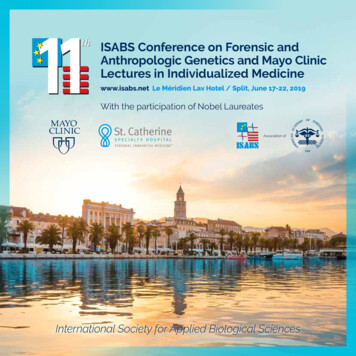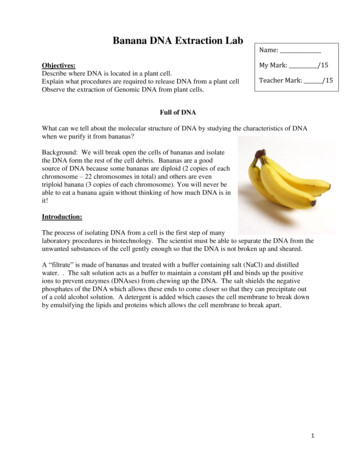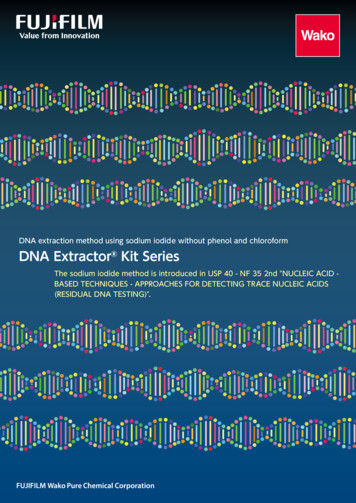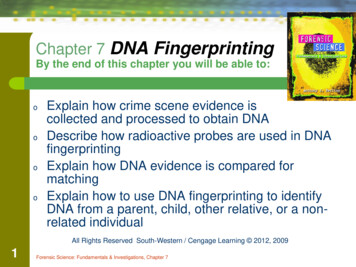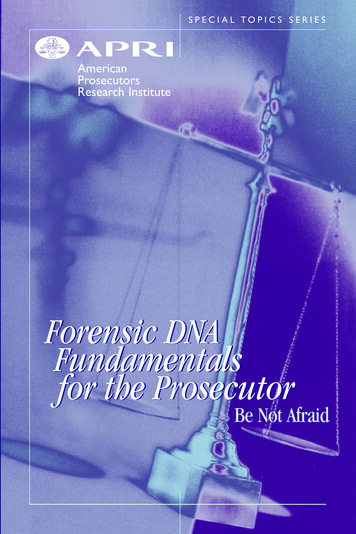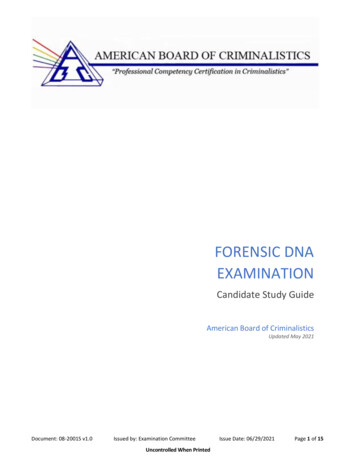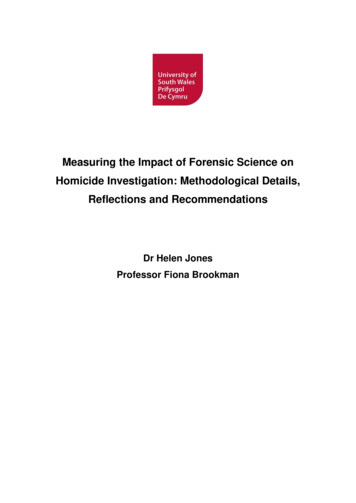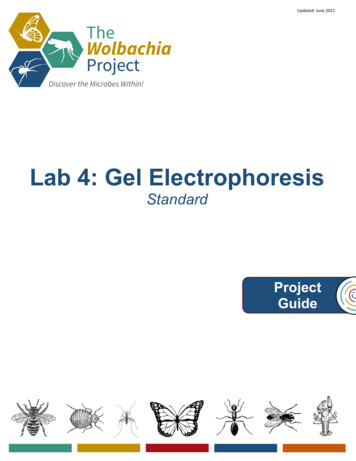
Transcription
ADVANCED TOPICS INFORENSIC DNA TYPINGPRELIMS.indd i5/24/2011 2:00:10 PM
This work was funded in part by the National Institute of Justice (NIJ) through interagency agreement 2008-DN-R-121 with the NIST Office of Law Enforcement Standards.Points of view in this document are those of the author and do not necessarily representthe official position or policies of the U.S. Department of Justice. Certain commercial equipment, instruments, and materials are identified in order to specify experimental proceduresas completely as possible. In no case does such identification imply a recommendation orendorsement by the National Institute of Standards and Technology nor does it imply thatany of the materials, instruments, or equipment identified are necessarily the best availablefor the purpose.Completed February 2011PRELIMS.indd ii5/24/2011 2:00:10 PM
ADVANCEDTOPICS INFORENSIC DNATYPING:METHODOLOGYJohn M. ButlerNational Institute of Standards and TechnologyGaithersburg, Maryland, USAAMSTERDAM BOSTON HEIDELBERG LONDON NEW YORKOXFORD PARIS SAN DIEGO SAN FRANCISCOSINGAPORE SYDNEY TOKYOAcademic Press is an imprint of ElsevierPRELIMS.indd iii5/24/2011 2:00:10 PM
Contribution of the National Institute of Standards and Technology, 2011Academic Press is an imprint of Elsevier225 Wyman Street, Waltham, MA 02451, USA525 B Street, Suite 1800, San Diego, California 92101-4495, USA84 Theobald’s Road, London WC1X 8RR, UK 2012 Elsevier Inc. All rights reservedNo part of this publication may be reproduced or transmitted in any form or by any means, electronicor mechanical, including photocopying, recording, or any information storage and retrieval system,without permission in writing from the publisher. Details on how to seek permission, furtherinformation about the Publisher’s permissions policies and our arrangements with organizations suchas the Copyright Clearance Center and the Copyright Licensing Agency, can be found at ourwebsite: www.elsevier.com/permissions.This book and the individual contributions contained in it are protected under copyright by thePublisher (other than as may be noted herein).NoticesKnowledge and best practice in this field are constantly changing. As new research and experiencebroaden our understanding, changes in research methods, professional practices, or medicaltreatment may become necessary.Practitioners and researchers must always rely on their own experience and knowledge in evaluatingand using any information, methods, compounds, or experiments described herein. In using suchinformation or methods they should be mindful of their own safety and the safety of others, includingparties for whom they have a professional responsibility.To the fullest extent of the law, neither the Publisher nor the authors, contributors, or editors, assumeany liability for any injury and/or damage to persons or property as a matter of products liability,negligence or otherwise, or from any use or operation of any methods, products, instructions, or ideascontained in the material herein.Library of Congress Cataloging-in-Publication DataButler, John M. (John Marshall), 1969Advanced topics in forensic DNA typing : methodology / John M. Butler.p. cm.ISBN 978-0-12-374513-21. DNA fingerprinting. 2. Forensic genetics. I. Title.RA1057.55.B87 2012614'.1–dc222011010514British Library Cataloguing-in-Publication DataA catalogue record for this book is available from the British LibraryFor information on all Academic Press publicationsvisit our Web site at www.elsevierdirect.comPrinted in China11 12 13 14 15 9 8 7 6 5 4 3 2 1ITR1.indd iv5/24/2011 7:27:01 PM
DedicationTo the hardworking professionalsthroughout the forensic DNA communityand the individuals and familiesimpacted by your service– your work makes a difference!DED.indd v5/24/2011 2:07:09 PM
DED.indd vi5/24/2011 2:07:09 PM
ContentsForeword ixIntroduction xiAcknowledgments xvAbout the Author ample Collection, Storage, and Characterization 1DNA Extraction Methods 29DNA Quantitation 49PCR Amplification: Capabilities and Cautions 69Short Tandem Repeat (STR) Loci and Kits 99Capillary Electrophoresis: Principles and Instrumentation 141Quality Assurance and Validation 167DNA Databases: Uses and Issues 213Missing Persons and Disaster Victim Identification Efforts 271Degraded DNA 293Low-Level DNA Testing: Issues, Concerns, and Solutions 311Single Nucleotide Polymorphisms and Applications 347Y-Chromosome DNA Testing 371Mitochondrial DNA Analysis 405X-Chromosome Analysis 457Non-human DNA 473New Technologies and Automation 497Legal Aspects of DNA Testing and the Scientific Expert in CourtAppendix 1Appendix 2Appendix 3Appendix 4515Reported Sizes and Sequences of STR Alleles 549Familial DNA Searches: Potential, Pitfalls, and Privacy ConcernsList of Suppliers for DNA Instruments, Reagents, Services 611Interviews Supporting Legal Aspects of DNA Testing 619603Subject Index 659viiPRELIMS1.indd vii5/24/2011 2:12:37 PM
PRELIMS1.indd viii5/24/2011 2:12:37 PM
ForewordOnce again, John Butler has provided the forensic community with a much needed definitive text. Several editions of the original book have appeared since 2000. It has now evolvedinto a project, as the original will no longer fit easily into a single volume. This is now thesecond book in the series—Advanced Topics in Forensic DNA Typing: Methodology.The information provided is easily amenable to a wide audience, from scientists and lawyers to the interested public. The comprehensive referencing makes it a handy documentto refer to when “giving evidence” in court, as a definitive authority on the “state of thescience.”The new volume is organized in the same order as the work flow, beginning with “samplecollection and storage.” The second and subsequent chapters provide comprehensive reviewsof extraction methods, quantitation, amplification, and separation. One important topic considered for the first time is the importance of manufacturing controls to prevent potentialcontamination of plasticware and other reagents, a problem first highlighted by the “Germanphantom.” The STR marker section is completely up to date, describing the EuropeanStandard Set (ESS) of markers and referring to a discussion on the proposed expansion of UScore loci. Each locus is described in turn, with details of their molecular structures and listingof aberrant alleles such as a point mutation in D16S539. There is a very useful comparison ofall STR typing kits along with their respective dye colors and sizes mapped for individual loci.There are comprehensive reviews of non-autosomal DNA: mitochondrial DNA,Y-chromosomal DNA, and a brand new chapter on X-chromosomal DNA.The chapter on degraded DNA leads into a discussion on the development of mini-STRsand their incorporation into the new multiplexes. John provides a timeline that stretches back17 years to 1994, where the first STR multiplex was used in the Waco disaster. The subsequentchapter is a discussion on low-copy-number (or low template) DNA analysis. A balancedreview is provided of this sometimes contentious area.The appendices are particularly interesting. They provide an updated compilation of allthe rare, and common, alleles currently observed and sequenced in the systems. The finalappendix contains interviews with highly experienced expert witnesses and attorneys, providing valuable perspectives on how to be a good witness. John’s books have become anessential adjunct to this objective.I look forward to the third volume in the series, and marvel that John can physically findthe time to do so much good work. I wonder what his secret is?Peter Gill, Ph.D.University of Oslo, NorwayixFOR.indd ix5/24/2011 2:28:55 PM
FOR.indd x5/24/2011 2:28:55 PM
IntroductionSince the second edition of Forensic DNA Typing was written in 2004, a great deal hashappened in the field of forensic DNA analysis. Hence, the need to update the information contained in the book in as comprehensive a manner as possible. In forensic sciencereview articles published in 2005, 2007, and 2009 in the journal Analytical Chemistry, I brieflydescribed topics from hundreds of articles published during the time frame of 2003–2008. Inmy own laboratory at the National Institute of Standards and Technology (NIST), we havepublished over 75 articles since 2004 on a variety of subjects including miniSTRs, Y-STRs,mtDNA, SNPs, validation, and DNA quantitation (see tm).Since 2004, I have also had the privilege of teaching more than three dozen workshops(see htm) to thousands of scientists andlawyers either at conferences or individual laboratories. In addition, I have responded tohundreds of email requests for more information on various topics. These interactions withforensic scientists, lawyers, and the general public have provided me with a valuable perspective on topics that need further clarification and questions that have not been answeredwith the information in the first or second edition of Forensic DNA Typing.I have divided what is essentially the third edition of Forensic DNA Typing up into threevolumes: a basic volume for students and beginners in the field and two advanced volumesfor professionals/practitioners who may be interested in more detail. The basic volume wasreleased in September 2009 (with a publication date of 2010) and is entitled Fundamentals ofForensic DNA Typing. The present book, Advanced Topics in Forensic DNA Typing: Methodology,is volume 2. A forthcoming book, to be titled Advanced Topics in Forensic DNA Typing:Interpretation, will be volume 3.Several reasons exist for dividing the material. First and foremost, people use booksmore frequently if they are less bulky. I have heard from more than one colleague at conferences that they prefer to carry the smaller first edition with them to court or other teachingsituations. Second, by having multiple books, each volume can be focused on its intendedaudience rather than trying to be all things to all readers. Third, the books will enable bothundergraduate and graduate studies with each building upon the previous volumes.With a vast majority of the topics, there is only minor overlap in subject matter betweenthe various volumes. The basic Fundamentals volume contains the simpler “starter” information while most of the “updates” to the field are found in the Advanced Topics volumes. It ismy intention that the three volumes together provide a comprehensive view of the currentstate of forensic DNA analysis.xiITR2.indd xi5/24/2011 2:32:41 PM
xiiINTRODUCTIONNEW MATERIAL IN THIS VOLUMEIn many ways, this is a completely new book. Those familiar with the previous editions of mybook will find that Advanced Topics in Forensic DNA Typing: Methodology is substantially enhancedwith additional information. Since the first edition was written in the winter months of 2000, thepublished literature on STR typing and its use in forensic DNA testing has grown dramatically.With more than 3,500 papers now available describing STR markers, technology for typing theseSTRs, and allele frequencies in various populations around the world, the scientific basis forforensic DNA typing is sound. The foundational material in the previous editions is still relevantand thus has remained essentially unchanged. However, as with every scientific field, advancesare being made and thus new information needs to be shared to bring the book up-to-date.In addition to updating information on essentially every topic in the second edition ofForensic DNA Typing, I have included new chapters on X-chromosome markers (Chapter 15)and legal aspects of serving as an expert witness in a U.S. court of law (Chapter 18). Thechapter on DNA databases (Chapter 8) is significantly expanded and new information onfamilial DNA searches is included (Appendix 2).At the end of each chapter throughout the book, I have included a fairly comprehensivelist of references that serve as a foundation for citations found throughout the chapter aswell as a launching point where interested readers can go for additional information. Morethan 2800 references are provided enabling readers to expand their study beyond the information contained between the covers of this book. References to journal articles includetitles to enhance value.In this edition, I again utilize Data, Notes, and Applications (D.N.A.) Boxes to cover specific topics of general interest, to review example calculations, or to cover a topic that servesto highlight information needed by a DNA analyst.OVERVIEW OF BOOK CHAPTERSMany times information within chapters and even the order of the chapters themselveshave been changed from the second edition. These structural changes reflect changes in myway of thinking about how to present the information to the intended audience. Note thatnew topics are being added and old ones phased out. A brief “cross-walk” of major topicscovered across the various editions of Forensic DNA Typing is shown below with chapters(Ch.) and appendices (App.) indicated. Note that although topics are defined for the forthcoming Interpretation volume, final chapter numbers are still to be determined (TBD).Topic1st Edition(2001)2nd Edition(2005)Fundamentals(2009)Advanced Topics: Advanced )History of DNACh. 1Ch. 1Ch. 1 & 3––DNA basicsCh. 2Ch. 2Ch. 2––Sample collectionCh. 3Ch. 3Ch. 4Ch. 1–(Continued)ITR2.indd xii5/24/2011 2:32:41 PM
xiiiINTRODUCTION(Cont’d)ITR2.indd xiiiTopic1st Edition(2001)2nd Edition(2005)Fundamentals(2009)Advanced Topics: Advanced )DNA extractionCh. 3Ch. 3Ch. 5Ch. 2–DNA quantitationCh. 3Ch. 3Ch. 6Ch. 3–PCRCh. 4Ch. 4Ch. 7Ch. 4–STR markersCh. 5Ch. 5Ch. 8Ch. 5–Data interpretationCh. 6 & 13Ch. 6 & 15Ch. 10–TBDDNA databasesCh. 16Ch. 18Ch. 12Ch. 8–CapillaryelectrophoresisCh. 9 & 11Ch. 12 & 14Ch. 9Ch. 6TBDFMBIO gel imagingsystemCh. 12Ch. 14DNA Box 9.2––Random match–probability calculationsCh. 21Ch. 11–TBDStatistics & probabilitybasics–Ch. 19App. 3–TBDFamilial searching––Ch. 12 (p. 282)App. 2–DNA mixturesCh. 7Ch. 7Ch. 14–TBDLow copy numberDNA testing–Ch. 7Ch. 14Ch. 11TBDValidationCh. 14Ch. 16Ch. 13Ch. 7–SNPsCh. 8Ch. 8Ch. 15Ch. 12–Y-STRsCh. 8Ch. 9Ch. 16Ch. 13–mtDNACh. 8Ch. 10Ch. 16Ch. 14–X-STRs–––Ch. 15–Non-human DNACh. 8Ch. 11Ch. 15Ch. 16–New technologiesCh. 15Ch. 17Ch. 18Ch. 17–Disaster victimidentificationCh. 17Ch. 24Ch. 17Ch. 9–Expert witnesstestimony–––Ch. 18, App. 4–Reported STR allelesApp. 1App. 1–App. 1–FBI QASApp. 3(1998/99)App. 4(1998/99)––TBDGlossary––App. 1––5/24/2011 2:32:41 PM
xivINTRODUCTIONAppendicesThere are four appendices at the back of the book that provide supplemental material. ITR2.indd xivAppendix 1 describes all reported alleles for the 13 CODIS and other commonly usedSTR loci as of December 2010. Sequence information, where available, has been includedalong with the reference that first described the noted allele. As most laboratories nowuse either a Promega or an Applied Biosystems STR typing kit for PCR amplification, wehave listed the expected size for each allele based on the sequence information.Appendix 2 discusses familial DNA searching and the potential, pitfalls, and privacyconcerns surrounding this controversial technique.Appendix 3 is a compilation of companies and organizations that are suppliers of DNAanalysis equipment, products, and services. Over 80 companies are listed along with theiraddresses, phone numbers, Internet web pages, and a brief description of their productsand/or services.Appendix 4 is a compilation of responses to interview questions asked of severalscientists and lawyers relating to issues faced when serving as an expert witness.5/24/2011 2:32:41 PM
AcknowledgmentsI express a special thanks to colleagues and fellow researchers who kindly provided important information and supplied some of the figures for this book or previous editions of ForensicDNA Typing. These individuals include Michael Baird, Susan Ballou, Brad Bannon, Martin Bill,Theresa Caragine, George Carmody, Mike Coble, Robin Cotton, David Duewer, Dan Ehrlich,Nicky Fildes, Lisa Forman, Ron Fourney, Lee Fraser, Richard Guerrieri, Chip Harding, DougHares, Bruce Heidebrecht, Debbie Hobson, Bill Hudlow, Ted Hunt, Dennis Kilcoyne, MargaretKline, Ken Konzak, Carll Ladd, Steve Lee, Dina Mattes, Bruce McCord, Ruth Montgomery,Steven Myers, Steve Niezgoda, Thomas Schnibbe, Richard Schoske, Jim Schumm, Scott Scoville(and the Orange County DA’s DNA Unit), Bob Shaler, Michelle Shepherd, Gary Sims, MelissaSmrz, Amanda Sozer, Jill Spriggs, Mark Stolorow, Kevin Sullivan, Lois Tully, and CharlotteWord.I am indebted to the dedicated Human Identity Project team members, past and present,who work with me at the U.S. National Institute of Standards and Technology: Jill Appleby,Erica Butts, Mike Coble, Amy Decker, David Duewer, Becky Hill, Margaret Kline, Kristen LewisO’Connor, Jan Redman, Dennis Reeder, Patti Rohmiller, Christian Ruitberg, Richard Schoske,and Pete Vallone. It is a pleasure to work with such supportive and hard-working scientists.Several other people deserve specific recognition for their support of this endeavor. Theinformation reported in this book was in large measure made possible by a comprehensivecollection of references on the STR markers used in forensic DNA typing. For this collectionnow numbering more than 3000 references, I am indebted to the initial work of ChristianRuitberg for tirelessly collecting and cataloging these papers and the steady efforts of JanRedman to monthly update this STR reference database. A complete listing of these references may be found at http://www.cstl.nist.gov/biotech/strbase.My wife Terilynne, who carefully reviewed the manuscript and made helpful suggestions, was always a constant support in the many hours that this project took away fromour family. As the initial editor of all my written materials, Terilynne helped make the bookmore coherent and readable. In addition, David Duewer and Katherine Sharpless provideda fine technical review of the Fundamentals book as well as this one. Review of materialsand input from Mary Satterfield and several members of my research group was also veryhelpful. The support of NIST management especially Laurie Locascio and Willie May madecompletion of this book possible.I was first exposed to forensic DNA typing in 1990 when a friend gave me a copy ofJoseph Wambaugh’s The Blooding to read, and since then I have watched with wonder as theforensic DNA community has rapidly evolved. DNA testing that once took weeks can nowbe performed in a matter of hours. I enjoy being a part of the developments in this field andhope that this book will help many others come to better understand the fundamental principles behind the biology, technology, and genetics of STR markers.xvACK.indd xv5/24/2011 2:26:36 PM
ACK.indd xvi5/24/2011 2:26:36 PM
About the AuthorJohn Marshall Butler grew up in the U.S. midwest and, enjoying science and law, decidedto pursue a career in forensic science at an early age. After completing an undergraduate education at Brigham Young University in chemistry, he moved east to pursue graduate studiesat the University of Virginia. While a graduate student, he enjoyed the unique opportunityof serving as an FBI Honors Intern and guest researcher for more than two years in the FBILaboratory’s Forensic Science Research Unit. His Ph.D. dissertation research, which was conducted at the FBI Academy in Quantico, Virginia, involved pioneering work in applying capillary electrophoresis to STR typing. After completing his Ph.D. in 1995, Dr. Butler obtaineda prestigious National Research Council postdoctoral fellowship to the National Institute ofStandards and Technology (NIST). While a postdoc at NIST, he designed and built STRBase,the widely used Short Tandem Repeat Internet Database (http://www.cstl.nist.gov/biotech/strbase) that contains a wealth of standardized information on STRs used in human identityapplications. He worked for several years as a staff scientist and project leader at a Californiastartup company named GeneTrace System developing rapid DNA analysis technologiesinvolving time-of-flight mass spectrometry. In the fall of 1999, he returned to NIST to leadtheir efforts in human identity testing with funding from the National Institute of Justice.Dr. Butler is currently a NIST Fellow and Group Leader of Applied Genetics in theBiochemical Science Division at the National Institute of Standards and Technology. He isa regular invited guest of the FBI’s Scientific Working Group on DNA Analysis Methods(SWGDAM) and a member of the Department of Defense Quality Assurance OversightCommittee for DNA Analysis. Following the terrorist attacks of September 11, 2001, he aidedthe DNA identification efforts and served as part of the distinguished World Trade CenterKinship and Data Analysis Panel (WTC KADAP). He is a member of the International Societyof Forensic Genetics and serves as an Associate Editor for Forensic Science International: Genetics.Dr. Butler has received numerous awards including the Presidential Early Career Award forScientists and Engineers (2002), the Department of Commerce Silver Medal (2002) and GoldMedal (2008), the Arthur S. Flemming Award (2007), the Edward Uhler Condon Award (2010),Brigham Young University’s College of Physical and Mathematical Sciences Honored Alumnus(2005), and the Scientific Prize of the International Society of Forensic Genetics (2003).He has more than 100 publications describing aspects of forensic DNA testing and isone of the most prolific active authors in the field with articles appearing regularly in everymajor forensic science journal. Dr. Butler has been an invited speaker to numerous nationaland international forensic DNA meetings and in the past few years has spoken in Germany,France, England, Canada, Mexico, Denmark, Belgium, Poland, Portugal, Cyprus, TheNetherlands, Argentina, Japan, and Australia. Much of the content in this book has come fromhis Group’s research efforts over the past two decades. In addition to his busy scientific career,he and his wife serve in their community and church and are the proud parents of six children, all of whom have been proven to be theirs through the power of DNA typing.xviiBIO.indd xvii5/24/2011 2:34:55 PM
Forensic DNA Typing. The present book, Advanced Topics in Forensic DNA Typing: Methodology, is volume 2. A forthcoming book, to be titled Advanced Topics in Forensic DNA Typing: Interpretation, will be volume 3. Several reasons exist for dividing the material. First and foremost, people use books more frequently if they are less bulky.
